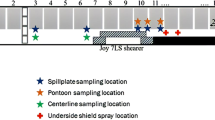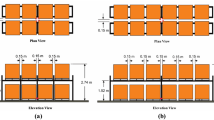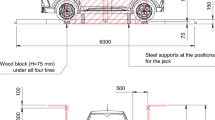Abstract
This report provides an evaluation of the firefighting capabilities of fixed pressure water spray systems for machinery spaces as described in Regulation 10 of Safety of Life at Sea (SOLAS). The objective of this evaluation was to determine if a system meeting the minimum SOLAS requirement can provide adequate protection of shipboard machinery spaces. To meet this objective, the capabilities and limitations of twelve water spray systems were determined using the International Maritime Organization (IMO) test protocol for water mist systems (MSC 668 and 728) as the basis for this analysis. The tests were conducted in a simulated 500-m3 machinery space onboard the U.S. Coast Guard's test vessel STATE OF MAINE. Generally speaking, the trends in performance of water spray systems were similar to those observed for water mist systems. All systems were capable of extinguishing larger fires (4 kW/m3 and greater) with variations in system capabilities becoming apparent as the fire size was reduced (2 kW/m3 and below). Only about half of the systems were capable of extinguishing the 1.0 MW obstructed spray fire located on the side of the engine mock-up (similar to IMO-6). Water mist systems typically exhibit slightly better capabilities primarily against the smaller fires. It was concluded that the capabilities of these systems cannot be associated with a single parameter such as application rate and must be determined empirically. As a result, the approval of these systems needs to be performance based as with all other fire suppression systems required by SOLAS. It was recommended that SOLAS Regulation 10 be re-written to cover all water based machinery space systems with the caveat that they pass a modified IMO test protocol based on the one currently used for approving water mist systems [MSC 668 and 728].
Similar content being viewed by others
References
G.G. Back, C.L. Beyler, P.J. DiNenno, E.W. Forssell, M.J. Peatross, R. Hansen, D. Waller, and R. Zalosh, “An Evaluation of the International Maritime Organization's Gaseous Agents Test Protocol,” Report No. CG-D–24–97, U.S.Coast Guard, Groton, CT, October 1997.
G.G. Back, E.W. Forssell, C.L. Beyler, P.J. DiNenno, R. Hansen, and D. Beene, “AnEvaluation of the International Maritime Organization's Gaseous Agents Test Protocol with Halocarbon Agents and an Inert Gas, 180 Degree Nozzles, and Low Temperature Conditioned Cylinders,” Report No. CG-D–02–99, U.S.Coast Guard, Groton, CT, December 1998.
G.G. Back, C.L. Beyler, P.J. DiNenno, and R. Hansen, “Full-Scale Water Mist Design Parameters Testing,” Report No. CG-D–03–99, U.S.Coast Guard, Groton, CT, February 1999.
G.G. Back, B.Y. Lattimer, C.L. Beyler, and H.R. DiNenno, “Full-Scale Testing of Water Mist Fire Suppression Systems for Small Machinery Spaces and Spaces with Combustible Boundaries,” Report No. CG-D–21–99, U.S.Coast Guard, Groton, CT, October 1999.
G.G. Back, C.L. Beyler, P.J. DiNenno, and R. Hansen,“Water Mist Protection Requirements for Verv Large Machinery Space,” Report No. CG-D–15–00, U.S.Coast Guard, Groton, CT, 2000.
International Maritime Organization, “Guidelines forApproval of Equivalent Gas Fire-Extinguishing Systems, as Referred to in SOLAS 74, for Machinery Spaces and Cargo Pump-Rooms,” Annex to IMO Maritime Safety Committee Circular 848, June 8, 1998.
46 CFR, “Code of Federal Regulations,” Washington, DC, 1998.
International MaritimeOrganization, “FTP Code, International Code for Application of Fire Test Procedures,” London, England, 1998.
NFPA 13, Standard for the Installation of Sprinkler Systems, 1996 ed., Quincy,MA: National Fire Protection Association, 1996.
NFPA 15, Water Spray Fixed Systems forFire Protection, 1996 ed., Quincy, MA: National Fire Protection Association, 1996.
G.G. Back, C.L. Beyler, and R. Hansen, “The Capabilities and Limitations of Total FloodingWater Mist Fire Suppression Systems in Machinery Space Applications,” Fire Technology, vol.36, February 2000, pp.8–23.
G.G. Back, C.L. Beyler, P.J. DiNenno, and R. Hansen,“Water Spray Protection of Machinery Spaces,” Report No.CG-D–04–01, U.S.Coast Guard, Groton, CT, March 2001.
C. Beyler, “Flammability Limits of Premixed and Diffusions Flames,”The SFPE Handbook of Fire Protection Engineering, Section l/Chapter 7, Quincy, MA: National Fire Protection Association, 1995.
G.G. Back, C.L. Beyler, and R. Hansen, “A Ouasi-Steady-State Model for Predicting Fire Suppression in Spaces Protected by Water Mist Systems,” Fire Safety Journal, vol.35, November 2000, pp.327–362.
Author information
Authors and Affiliations
Rights and permissions
About this article
Cite this article
Hansen, R.L., Back, G.G. Water Spray Protection of Machinery Spaces. Fire Technology 37, 317–326 (2001). https://doi.org/10.1023/A:1012720831429
Issue Date:
DOI: https://doi.org/10.1023/A:1012720831429




